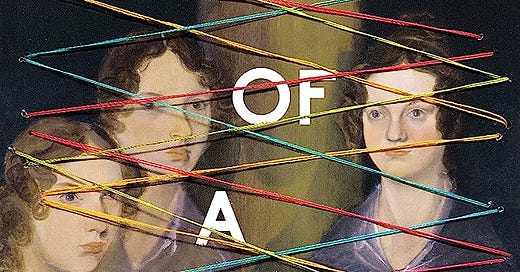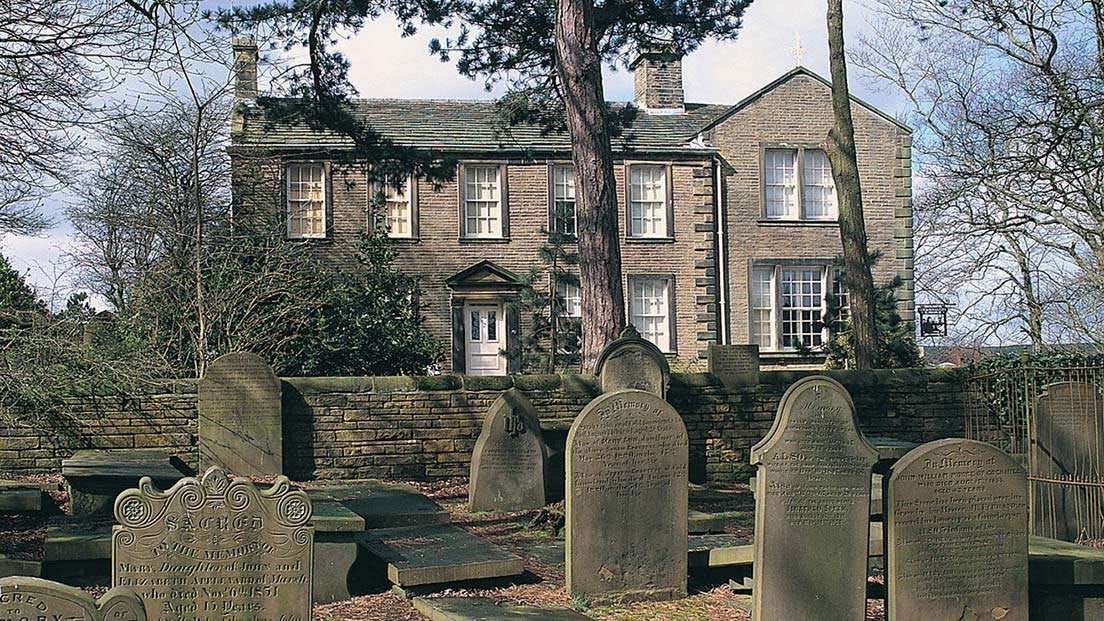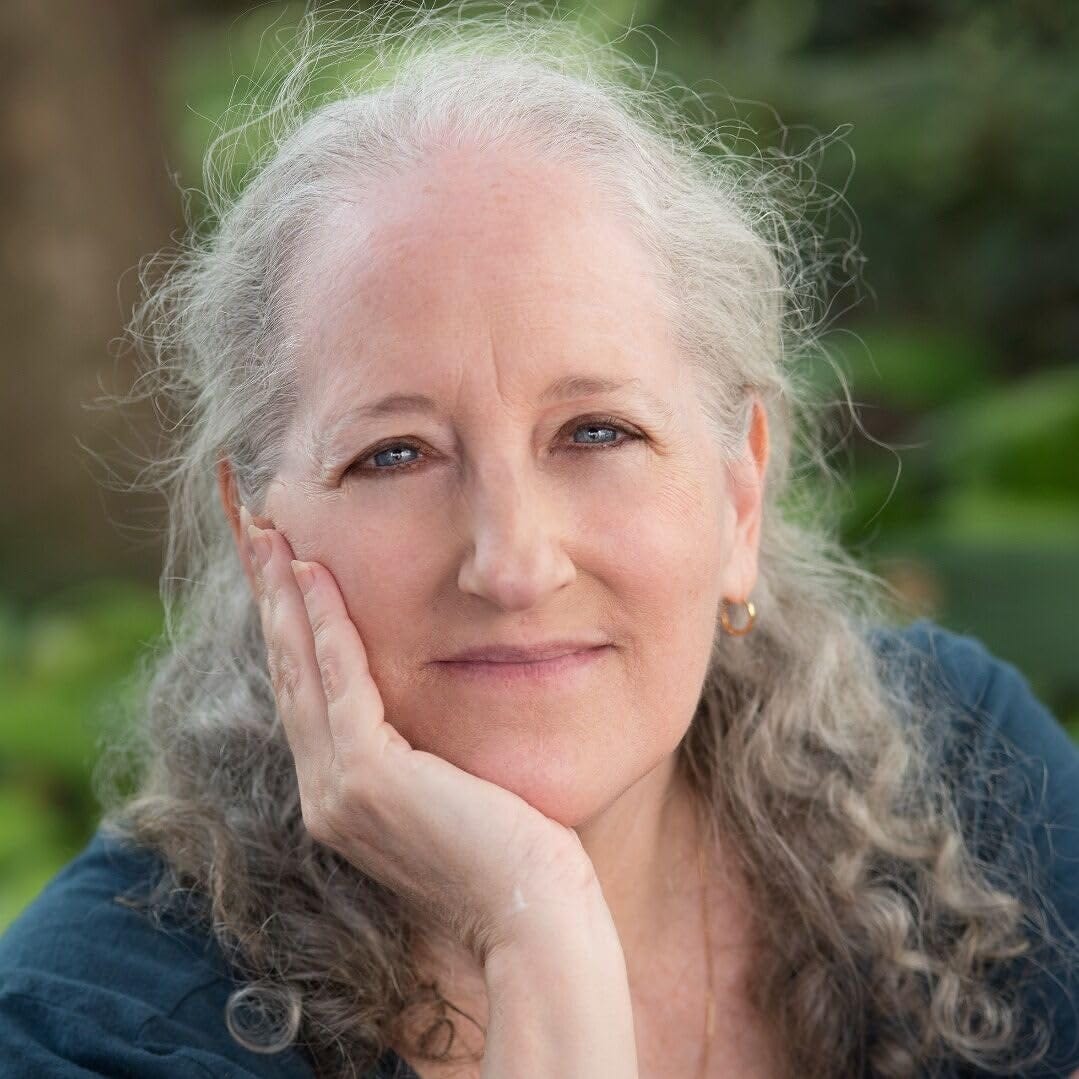Like so many girls, I was enamored of Jane Eyre and Wuthering Heights.
The darkness! The romance! Their authors’ early deaths!
It wasn’t until I visited the Brontë parsonage in Haworth in the 1990s that I knew there was a third sister, Anne, who’d written novels, too—and also died young. And a brother, Branwell, brilliant and pathetic, who died young of drink. Not to mention Maria and Elizabeth, the oldest Bronte children, dead at ten and eleven.
The visit was also my introduction to the Brontë Myth: four motherless young geniuses, living in near-poverty, cut off from society, with only themselves for company. Charlotte, Emily and Anne pacing around the dining room table every evening, translating their grief and misfortune into the novels we now know as classics. The tragedy of their early deaths.
It was pretty much a Charlotte and Emily show, though; the high point of the tour was the blue velvet couch upon which Emily died. Anne didn’t even make it into the family crypt, which made my traveling companion and I feel bad for her. So, after a brief, obligatory trek, on the moors, we headed for Scarborough to visit her grave.
It was a bigger town than we expected, and early evening by the time we arrived, so the Information Center was closed. We drove around for a while, discovering only that there were a lot of churches in Scarborough. We sent up a little “sorry” to Anne and took a road heading toward the shore to treat ourselves to fish and chips for our efforts. Passing yet another churchyard, we saw an open parking space, pulled in, and saw—directly before us:
All of which is to say that, for me, there was already a good measure of weirdness in my relationship to the Brontë sisters—and it enhanced my delight in reading Rachel Cantor’s Half Life of a Stolen Sister. In fact, I hesitate to tell you too much about the book for fear that a hint of how outrageously she reimagines the Brontës’ lives might diminish your pleasure in discovering this yourself.
But here goes.
Maria, known in Brontë lore as little more than the eldest sister, dead of tuberculosis at eleven, begins the book with, “Mama teaches the difference between us”—and I’m devastated by page two at how their dying mother knows exactly who her children are.
Branwell’s big heart must be tempered by self-control, or he will disappoint; Charlotte cares most for what she doesn’t have and must learn to care for what she has to be happy; Emily loves places than people, she’ll go away but she’ll aways come back; Anne will always be the baby, loved and underestimated.
Okay. I know Mrs. Brontë is Rachel Cantor’s creation. But what she tells her Cantor’s Maria about her siblings is totally spot on, despite the fact that the oldest of them would have been five years old at the time. Also, how can Cantor’s Maria not be real, as well, when I’m pierced by the death of her childhood that occurs with her mother’s words: “You are the Little Mother, the one who fills all the spaces.”
But wait. Describing what a Little Mother does, Maria tells us she “takes Bran to the park so he can run,” takes Em to the pound, where she “gives the dogs names and brings them treats.” Could there have been a park or dog pound in Haworth then?
A few pages later, Liza and Charlotte are playing dress up with clothes made of “names we have mostly forgotten. Muslin, velvet, cocktail.” I google. While cocktails were invented in the 17th century, “Christian Dior was the first to name the early evening frock a ‘cocktail’ dress in the late 40’s.”
Normally, a gaffe makes me so mad I’m likely to quit reading the book. Instead, I felt a funny little frisson of excitement. It wasn’t a gaffe.
Rachel Cantor did this on purpose.
The park and the dog pound, too.
Not to mention discount coupons, book clubs and spaghettios
If there’s a literary term for getting something wrong on purpose, I wish I knew what it was so I could use it to describe Half Life of a Stolen Sister, which is built of an astounding array of wrong things and impossibilities that by some magic make her story of the Brontës deeper and more real than any anything else I’ve read about them.
But, really, the book is indescribable.
Chapter by chapter, it brings together diaries, letters, home movies, television and radio interviews, deathbed monologues, and fragments of Glass Town, the siblings’ fantasy universe.
“I am an upright man, with a rent-controlled apartment,” Patrick Brontë writes in a marriage proposal.
I laughed out loud! Oh, my god! I thought. I can’t believe she’s doing this!
The Brontë children make their way in this wacky world considerably more real siblings than the brainiac icons literature has made them. There’s squabbling and blaming; envy and rage. Angry Charlotte, stubborn Emily, spoiled Branwell—it’s as if they’re elbowing each other aside to tell their stories. Even Anne, who seems in actual history and here, the most normal of them, perseveres, if quietly, in making her voice known.
Arguing for the worthiness of fiction about real people and events, I often say that good fiction can tell a deeper, truer story than facts can.
If you know what I mean and agree with me, you will love Half Life of a Stolen Sister. If you don’t know, read it—and you’ll understand.
Rachel Cantor kindly answered some questions about how the book came to be, but I have to admit that what she did still seems a bit like a miracle to me.
First, what did you know of the Brontës before the idea of writing about them occurred to you?
Jane Eyre was my favorite book as a child (and still is). But that’s pretty much all I knew of the Brontës till midlife, when I read Villette. The preface to that book detailed the family’s many losses—Charlotte’s losses, ultimately, because it was she who survived the death in childhood of the two oldest sisters and, later, the sudden deaths, within a terrible nine-month period, of Branwell, Emily, and Anne. The image of Charlotte grieving these many losses put the glimmer of an idea of an idea into my head. It was years before I could make good on this glimmer, at which point I read the remaining novels, as well as biographies, letters, juvenilia, and so on. Crazy to think I was almost this-years-old before I read Wuthering Heights!
Where did Half Life of a Stolen Sister begin for you? What was the first thing you wrote, what did it tell you what the book “wanted” to be?
When I picked up my figurative pen to write the first pages of Half-Life, I found the Brontë children running riot in a park, shouting into their “talkie-walkies,” and pretending to be spies (before jumping onto the subway to return to their rent-controlled apartment). I was gobsmacked, but knew immediately that this is what the book wanted to be. I had intended to write a “realistic” book of novellas, one each for Charlotte, Branwell (the brother), Emily, and Anne, but had the great good fortune to bring this idea to back-to-back writing residencies at MacDowell and Yaddo. For three months, I was fed, watered, and cared for—and surrounded by artists who were doing thrilling creative work. My early, quite conventional idea did not last a day in that environment!
Reading, I was often thrilled by how you were breaking every kind of rule of historical fiction—and not only getting away with it but creating a feel of intoxication that, for me, mirrored the Brontë children’s sense of themselves. Do you remember the first rule you broke and what that felt like?
Bringing the Brontë family to a twenty-first century, mid-sized North American city was probably the first rule I broke, but once I did that, I never for one moment viewed Half-Life of a Stolen Sister as historical fiction. If it takes place in the current day, how can it be historical? Lots of smart people think it is, however—after all, it concerns historical figures who speak and dress in a somewhat archaic way, and have some old-fashioned ideas—but I feel quite strongly that it is not.
I broke another rule, then, by using a variety of forms and points of view to tell their story—a dating-site profile when Papa seeks another mate; meeting minutes when Emily, “junior secretary,” gives notice to her law firm; postcards when Charlotte accompanies the dying Anne to the seaside.
Breaking these rules did in fact offer a quite marvelous freedom, which I found intoxicating—never knowing in advance what a telling of the next moment would involve, being open to literally any possibility, constantly rethinking and reframing what I thought I knew about the family. I’m glad that intoxication was evident!
The deliciously “wrong” details grow even bolder and more absurd as the story unfolds. What did it feel like to give yourself that kind of freedom?
After breaking those two big rules, I stuck very close to what was known about the Brontë lives—major events, relationships, turning points, etc.—so my freedom was far from absolute. The rule I appear to have made for myself was that I would not make up major events or speculate about events that weren’t documented; I would respect the historical record, as a way of respecting the “real” Brontës. Of course, because the book is set in the current day, I had to find “equivalents” for many events or historical moments. Badly run schools for the daughters of indigent clergy, for example, have, I hope, seen their day, but a child can still, unfortunately, die in foster care. A young person today without a college degree cannot hope to become a teacher, but she can become a receptionist—and so on.
What was the most difficult part of writing Half Life of a Stolen Sister?
Definitely writing the deaths of Branwell, Emily, and Anne. Losing them was so painful! It was also difficult from a technical point of view—how to write the deaths of three such young and fascinating and talented people, one after another after another? What can a reader take in after one such death? What about after two?
How does the book you imagined match up to the finished book on the page?
Once I understood what the book was (and again, this happened on the very first page), the book I imagined turned out to be the book I wrote. It’s the only book I could have written.
What have Brontë scholars had to say about the book?
I wish I knew! If they’re saying anything, they’re keeping it to themselves!
Click “Finding Anne,” for the rest of the story about my literary pilgrimage to Anne Brontë’s grave, recently published by “The Gutenborg Project.”









You will LOVE it!
Brilliant! (And, a masterclass in the Literary Interview.) Can’t wait to read this book!